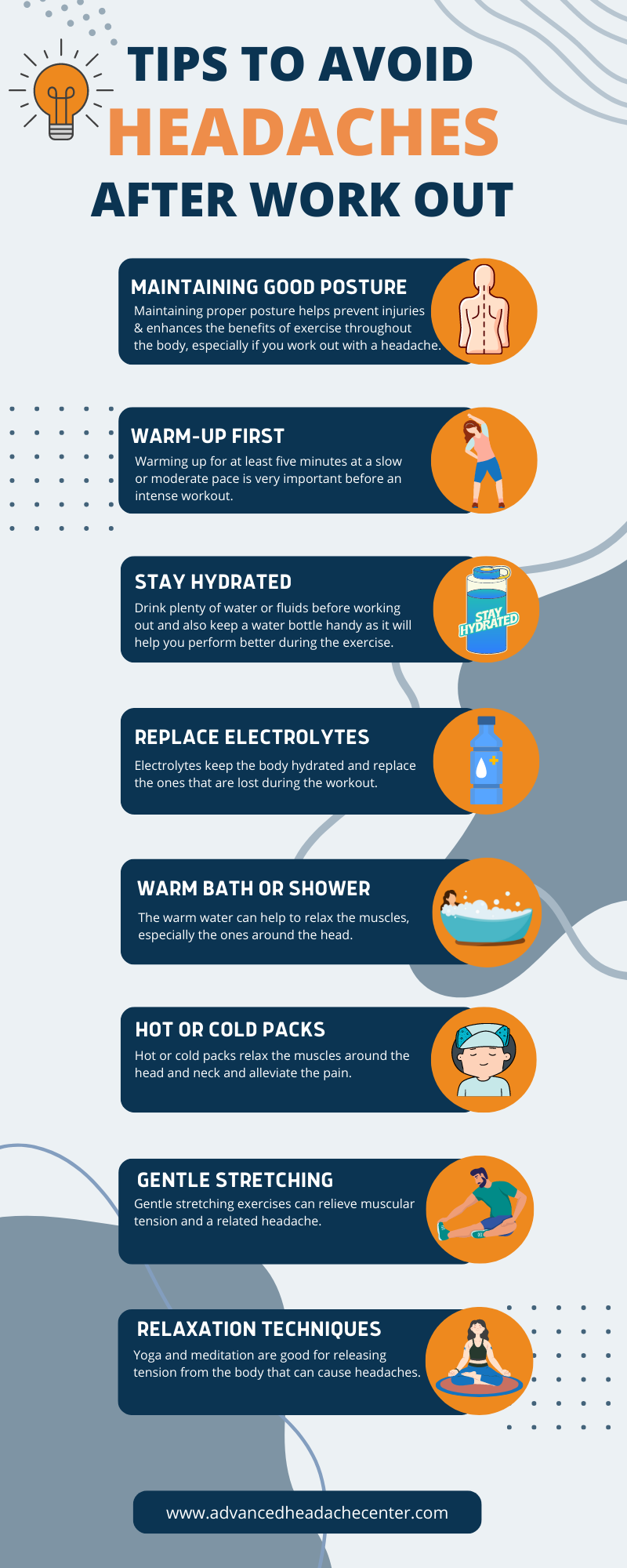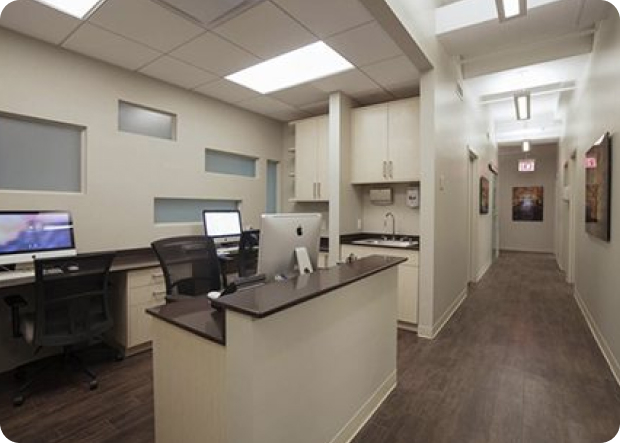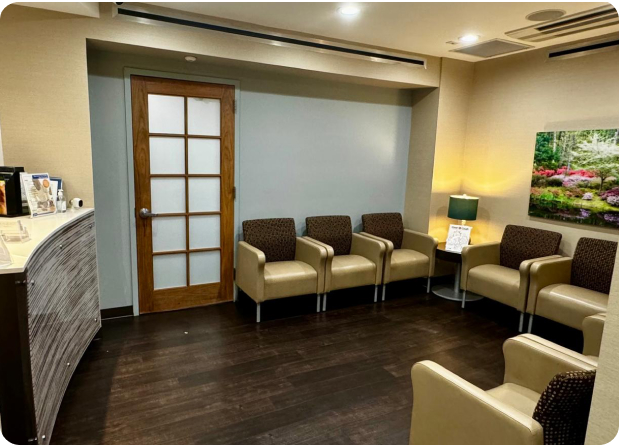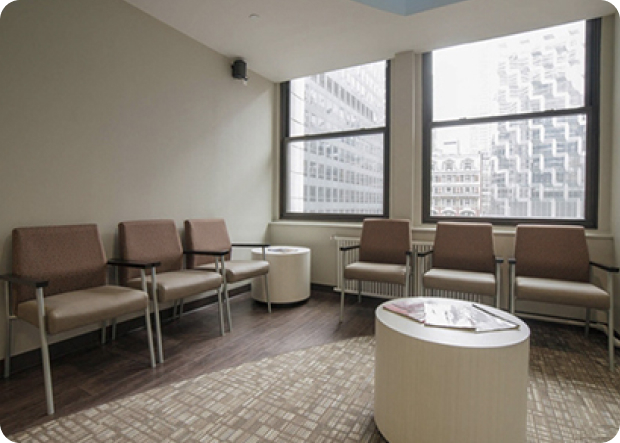If you continue to suffer from skull throbbing pain that prevents you from enjoying that refreshing feeling after a good workout, consult an expert physician to get your condition diagnosed. The experienced doctors at the Advanced Headache Center use the most cutting-edge diagnostic equipment and multidisciplinary approaches to treating such pain. They will help you find the most comprehensive and multidisciplinary treatment plan that targets your specific symptoms and provides relief from headaches after working out.
Headaches and Workout
Headache that occurs during or after a workout affects your exercise routine and mood. The pain is stubborn and does not relent, making it tough to carry on with the workout. It is known as a primary exertion headache or exercise-induced headache triggered by exercise.
Exertion headaches are caused by increased pressure on the blood vessels in the brain. Exercises like biking, running, push-ups or weightlifting are strenuous activities that make you sweat hard and trigger headaches. A headache after working out is not unusual. You might feel pain on one side of the head or throbbing pain across the crown after an exercise session.
You may end up suffering from a bad headache after working out that won’t go away. It might be simple to treat, but you need to consult an experienced physician to get quick and lasting relief.
Working out has numerous benefits. It is a great way to keep yourself fit and maintain overall good health. Regular exercise helps to build muscles and sustain healthy body weight. But there are times when working out might not be the best thing for your body. Experiencing headaches after working out that leave you weak and distressed is not a good sign and must be investigated.
What the Headache After Working Out Feels Like – Common Symptoms
Primary headaches after a workout are characterized by:
- Moderate to severe pain
- Throbbing headache
- Pain on one or both sides of the head
The headache may start during or after strenuous physical activity and last anywhere from 5 minutes to 48 hours.
Secondary exercise headaches have similar symptoms, but depending on the cause, they can also have additional ones, including:
- Double vision
- Vomiting
- Loss of consciousness
- Neck rigidity
- Extreme headache after working out
These symptoms can last several days longer than a primary headache, and only an experienced pain doctor can figure out what underlying condition is causing them.
[callPoint]
What Causes Headaches After Working Out?
You may develop a headache after exercising for several reasons. Common causes of headaches after a workout includes:
- Dehydration
- Working out in the heat
- Working out at high altitudes
- Muscle tension in the head or neck
- Lack of sleep
- Fluctuating blood pressure
- Migraine
You must seek a pain expert doctor to learn more about the causes and triggers of headaches and avoid them after the next workout. These headaches could also be a sign of some serious, undiagnosed medical condition. The doctor will suggest blood and imaging tests, collect your medical history, assess your physical health and analyze the symptoms to determine if these headaches are harmless or a result of some structural or vascular abnormality.
If you are not careful and focus on the doctor’s advice, you could end up aggravating the symptoms and dealing with something serious.
How to Avoid Headaches After Work Out?
Your doctor may recommend a few tips to exercise better and prevent such episodes.
- Maintaining good posture – maintaining proper posture helps prevent injuries and enhances the benefits of exercise throughout the body, especially if you work out with a headache.
- Warm-up first – warming up for at least five minutes at a slow or moderate pace is very important before an intense workout.
- Stay hydrated – drink plenty of water or fluids before working out and also keep a water bottle handy as it will help you perform better during the exercise.
- Replace electrolytes – electrolytes keep the body hydrated and replace the ones that are lost during the workout.
- Warm bath or shower – the warm water can help to relax the muscles, especially the ones around the head
- Hot or cold packs – hot or cold packs relax the muscles around the head and neck and alleviate the pain.
- Over-the-counter pain-relieving medications – they relieve mild to moderate headache pain.
- Relaxation techniques – yoga and meditation are good for releasing tension from the body that can cause headaches.
- Gentle stretching – gentle stretching exercises can relieve muscular tension and a related headache.
- Avoid mistakes during a workout – small mistakes during the workout can affect the blood flow to the brain and cause headaches afterward.
If the headache results from low blood sugar levels, eating a snack or a small meal can return the sugar level to normal and treat the headache.

Medications to Treat Workout Headaches
Over-the-counter medications are effective in preventing and treating primary exertion headaches. Your doctor may suggest the following medications:
- Nonsteroidal anti-inflammatory drugs such as Naproxen
- Ibuprofen such as Advil
- Acetaminophen such as Tylenol
You might be asked to take the medications 30 to 60 minutes before a workout to keep the pain away. You must use the medication according to the doctor’s instruction to prevent overdosage and tolerance to drugs.
How to Relieve a Pre or Post-Workout Headache?
Pre or post-workout headaches can be very annoying and affect your ability to exercise and enjoy physical activities. Sometimes these headaches are persistent and last for days making it very difficult to focus on your routine.
With the help of your pain management doctor, you can relieve pre or post-workout headaches by implementing simple, non-invasive treatment options for exercise.
[callPoint]
Pressure Points for Headache Relief
Pressure points are natural spots throughout the body that relieve pain when they are massaged a particular way. Stimulating pressure points can support healthy circulation that effectively relieves headaches that result from migraines and workouts. Your doctor may suggest pressure point therapy or acupressure relieve the headache symptoms.
There are several pressure points in the face and throughout the body that are particularly beneficial for relieving headaches, including sinus headache pressure, migraines, and tension-type headaches.
The most popular pressure points for headache relief in the facial region are:
- Facial Beauty Pressure Point
- Bright Light Pressure Point
- The Third Eye Pressure Point
- Welcome Fragrance Pressure Point
The doctor can guide you more about pressure points for headache relief and help you understand how this approach works.
Exercise to Relieve Headaches
Regular exercise can reduce the frequency and intensity of headaches and migraines, especially those caused by stress. Seek your doctor’s advice regarding light exercise and how it can help to manage stress and sleep better at night.
It would help if you remembered that it would take some time before lifestyle changes and other non-invasive treatment options help you fight these headaches.
Taking part in workouts with headaches is not dangerous if you know the causes behind them. Changing your exercise habits and following the right steps can improve your condition and keep the headaches away.
Suffering from a headache every time you work out might be a sign of some serious medical condition, and you must go for professional medical guidance. Schedule an appointment with the headache specialist near me at Advanced Headache Center for expert diagnosis and seek specialized help to get rid of these headaches. Our doctors will strive to resolve your pain and provide the best treatment for long-term relief.




